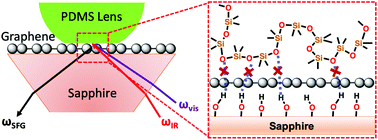Screening of hydrogen bonding interactions by a single layer graphene†
Abstract
A single layer of graphene when transferred to a solid substrate has the ability to screen or transmit interactions from the underlying substrate, which has direct consequences in applications of this 2D material to flexible electronics and sensors. Previous reports using a multitude of techniques present contradictory views on graphene's ability to screen or transmit van der Waals (vdW) and polar interactions. In the present study, we use interface-sensitive spectroscopy to demonstrate that a single layer graphene is opaque to hydrogen bonding interactions (a subset of acid–base interactions), answering a question that has remained unresolved for a decade. Similar frequency shifts of sapphire hydroxyl (OH) peak for graphene-coated sapphire in contact with air and polydimethylsiloxane (PDMS) demonstrate the insensitivity of sapphire OH to PDMS. The screening ability of graphene is also evident in the smaller magnitude of this frequency shift for graphene-coated sapphire in comparison to that for bare sapphire. The screening of acid–base interactions by a single layer graphene results in the significant reduction of adhesion hysteresis for PDMS lens on graphene-coated substrates (sapphire and silicon wafer, SiO2/Si) than bare substrates. Our results have implications in the use of PDMS stamps to transfer graphene to other substrates eliminating the need for a wet-transfer process.



 Please wait while we load your content...
Please wait while we load your content...